Top 30 Low-Maintenance Indoor Plants for Living Room
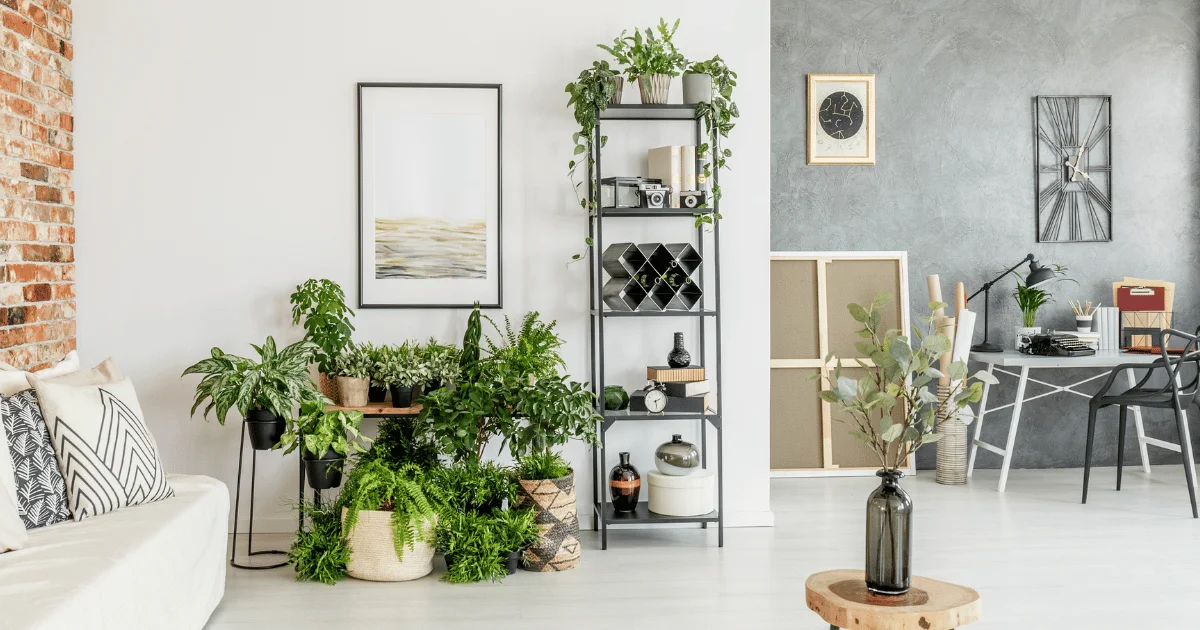
Imagine transforming your living room into a thriving, green sanctuary without the hassle of a green thumb. If you’re in search of a handpicked selection of indoor plants that demand minimal upkeep, possess air-purifying magic, and are endorsed by someone who has nurtured many of them in their own living room, you’ve stumbled upon the ultimate guide.
Drawing from my personal journey as an avid plant lover, I’m excited to walk you through the top 30 low-maintenance indoor plants tailor-made for your living space. These verdant companions not only enhance the aesthetics of your home but also labor diligently to purify the air you breathe. So, let’s embark on this green adventure and uncover the secrets to effortlessly elevate your home decor and indoor air quality.
List of 30 Best Low-Maintenance Indoor Plants (Air Purifying Plants Included):
1. Pink Polka Dot Plant
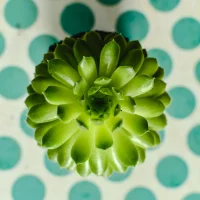
For a touch of colorful whimsy, the Pink Polka Dot Plant (known as Hypoestes phyllostachya) is a cool and colorful choice for your living room. Its pink leaves with green spots offer a delightful contrast, making it a visually appealing indoor plant.
Placed in a sunny location on solid surfaces like coffee or end tables, it brightens up the room. Its bushy growth habit, reaching 2½ feet in height and spread, brings a playful yet sophisticated touch to your living space.
The ASPCA states that the Pink Polka Dot Plant is not considered a toxic plant for cats, dogs, or horses.
Pink polka dot plant care tips:
- Gentle Sunlight: Place your Pink Polka Dot Plant in bright, indirect light to preserve its vibrant hues, avoiding direct sunlight that may cause fading.
- Moisture Moderation: Maintain consistent soil moisture without waterlogging. Water when the top inch feels dry, ensuring proper drainage.
- Trimming Technique: Prune leggy growth to promote a fuller, bushier appearance, ensuring a lush and visually appealing Pink Polka Dot Plant
2. Air Plant
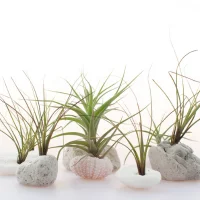
Air Plant, a quirky and intriguing choice, thrives without soil, offering a modern, minimalist appeal. Its ability to live on air, with occasional misting or soaking, categorizes it among the best low-maintenance indoor plants.
The versatility of Air plants allows for creative displays, whether in terrariums, mounted on walls, or placed in decorative containers, adding a unique, whimsical touch to your living room.
Belonging to the Bromeliad family, Air plants are deemed entirely non-toxic, making them safe companions for both humans and pets.
Air plant care tips:
- Watering Technique: Mist every 2-3 days or soak for 30 minutes every 7-10 days. Dry upside down post-watering to prevent rot.
- Lighting Preferences: Place near a window for bright, indirect sunlight or under fluorescent lighting, avoiding harsh afternoon sun.
- Fertilization: During warmer months, use water-dissolvable or Bromeliad fertilizer 1-2 times a month for blooming and reproduction.
See Also: What Fruits Grow in 30 Days
3. Prayer Plant (Maranta Leuconeura)
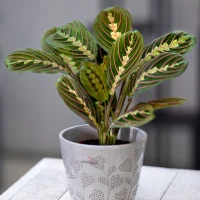
Prayer Plant, known for its vibrant, intricately patterned leaves, brings a lively splash of color to your interior. Its name comes from how its leaves fold together at night, resembling hands in prayer.
This plant is not only a visual delight but also a manageable companion, fitting well in the category of low-maintenance indoor plants. It thrives in medium to bright indirect light, offering a captivating display as it unfolds its leaves with the morning sun.
Known as Maranta Leuconeura, the Prayer plant, is non-toxic and safe for cats and dogs.
Prayer plant (Maranta leuconeura) care tips:
- Low Light Specialist: Opt for indirect, low to medium light to shield your Prayer Plant from leaf scorching, making it perfect for shaded corners or spaces with filtered light.
- Hydration Harmony: Keep soil consistently moist but not waterlogged. Water when the top inch feels dry, using room-temperature, filtered water to avoid mineral buildup.
- Humidity Haven: Maintain high humidity levels through regular misting or placing a nearby water tray. This replicates its tropical habitat, ensuring vibrant, healthy leaves.
4. Orchids
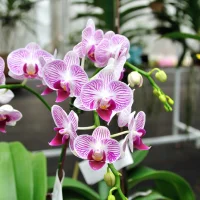
Orchids are synonymous with elegance and exotic beauty. Their delicate blooms in various colors can enhance the aesthetic appeal of any living space.
Orchids are often considered a sophisticated choice for indoor plants for air purifying, as they absorb pollutants during the day and release oxygen at night. With a little attention to their light and watering needs, orchids can be a long-lasting, blooming addition to your living space.
Orchid flowers are generally non-toxic to humans, and though ingesting them might lead to a feline tummy ache and vomiting, the ASPCA confirms that orchids are not harmful to cats, dogs, and horses.
Orchids care tips:
- Optimal Lighting: Place orchids near east or west-facing windows to provide bright, indirect sunlight without direct exposure to the sun’s harsh rays.
- Watering Wisdom: Water sparingly, allowing the top inch of potting mix to dry before watering with room-temperature water. Ensure effective drainage to prevent root rot.
- Potting Mix Precision: Use a well-draining orchid potting mix to maintain root health, allowing for both airflow and moisture retention in line with their epiphytic nature
5. Parlor Palm
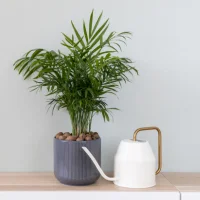
Parlor Palm, a classic favorite, emanates a timeless elegance with its feathery, arching fronds. With the right care, it can grow 4 to 8 feet tall. This petite palm is perfect for adding a touch of nature without overwhelming the space, making it a lovely indoor plant for living room corners.
It’s also among the low-maintenance best indoor plants for the living room, requiring minimal care while offering a calm, tropical vibe. Its tolerance to lower light conditions and less frequent watering make it a beginner-friendly choice.
The elegant Parlour Palm, alongside the orchid, is also a dog-friendly choice among houseplants.
Parlor Palm care tips:
- Gentle Lighting: Position in low to moderate indirect light; too much sunlight can cause leaf burn.
- Consistent Moisture: Keep soil evenly moist, but not waterlogged; drainage is key to prevent root rot.
- Regular Dusting: Wipe leaves with a damp cloth occasionally to remove dust, aiding in photosynthesis and maintaining a lush appearance.
Also Read: Why Are Tomatoes Flowering But Not Fruiting?
6. Cast Iron Plant
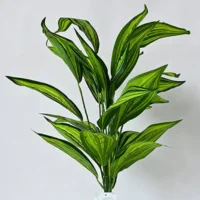
The Cast Iron Plant lives up to its name, showcasing remarkable resilience. It thrives in low light and requires minimal watering, categorizing it among the low-maintenance best indoor plants for the living room.
Its long, dark green leaves bring a touch of simplicity and elegance, making it a versatile choice for various interior styles. Its ability to withstand neglect makes it an ideal choice for those with a hectic lifestyle or beginners stepping into the realm of indoor gardening.
Cast iron plant stands as a completely non-toxic sanctuary, ensuring safety for pets, children, and any curious nibblers among houseplants.
Cast iron plant care tips:
- Low Light Tolerance: Thrives in low light conditions, making it suitable for dimly lit spaces.
- Sparse Watering: Allow soil to dry out between waterings to prevent root rot, adapting to its drought-tolerant nature.
- Cool Comfort: Prefers cooler temperatures, keep it in a spot away from direct heat sources like radiators or heaters.
7. Money Tree
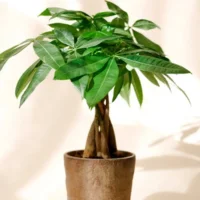
Money Tree, with its braided trunk and lush, green leaves, is often associated with good fortune and prosperity. Besides its symbolic significance, it’s a stunning addition to any living space.
Its compact size makes it an attractive indoor plant for living room corners. Money Tree thrives in moderate light and requires well-draining soil, making it a delightful and meaningful addition to your living room.
Money Tree is a pet and child-friendly option, highly endorsed for individuals coping with allergies and asthma.
Money tree care tips:
- Sunlight Moderation: Position in a spot with moderate to bright indirect light, avoiding direct sunlight to prevent leaf scorch.
- Watering Discipline: Water thoroughly but allow the soil to dry out slightly between waterings, ensuring a well-draining soil to prevent waterlogging.
- Occasional Fertilization: During growing seasons, spring and summer, apply a balanced, slow-release fertilizer every two months to support robust growth.
8. Bromeliad
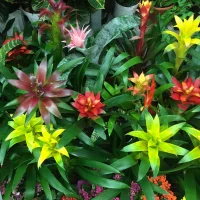
Bromeliads are a delightful choice for those seeking low-maintenance best indoor plants for the living room. Their ease of nurturing and unique appearance, characterized by a rosette of spiky leaves and a brightly colored flower stalk, make them a captivating addition.
Being easy to find and display, Bromeliads add a lively touch to your living space, especially when placed in well-lit corners, enhancing the aesthetics of your living room corner.
Bromeliad plants are safe for both children and pets, as they are non-toxic. However, it’s advisable to keep houseplants away from children, especially if they have allergies
Bromeliad care tips:
- Light Brilliance: Position your Bromeliad in bright, indirect sunlight, ensuring it gets sufficient light for vibrant foliage.
- Water Wisdom: Fill the central cup (tank) with water, keeping it clean. Water the soil sparingly to avoid waterlogged conditions.
- Feeding Strategy: Use a diluted liquid fertilizer every 2-3 months during the growing season on the soil to support healthy growth
You May Like: What Vegetables Can Grow in 4 Hours of Sun Daily?
9. Peace Lily
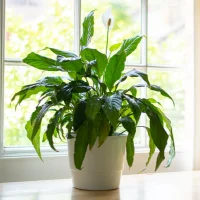
Next on our list is the Peace Lily, a graceful plant with glossy green leaves and white blooms that exude tranquility. This plant doesn’t just add a touch of elegance; it’s also among the renowned indoor plants for living room air purifying.
Its ability to cleanse the air of harmful substances like formaldehyde and benzene is a boon for urban dwellers. The Peace Lily is relatively easy to care for and thrives in low to medium-light conditions, making it a hassle-free choice for any homeowner.
Keep your Peace Lily in a safe spot as it can be toxic to pets and children if ingested. Peace Lily’s calcium oxalates may cause skin rashes, mouthburn, swallowing issues, and nausea
Peace lily care tips:
- Lighting: Position your Peace Lily in a spot with low to medium, indirect light, avoiding direct sunlight to prevent leaf burn.
- Watering: Water your Peace Lily when the soil feels dry to the touch or the leaves start to droop, making sure not to over-water.
- Fertilization: Fertilize every 6-8 weeks with a balanced, indoor plant fertilizer during the growing season (spring and summer), reducing to every 3 months in fall and winter.
- Blooming: Encourage blooming by providing adequate light, keeping the soil moist, and considering the use of a balanced fertilizer.
10. Spider Plant
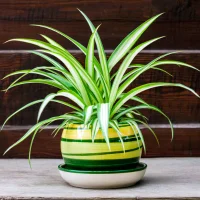
Venturing into the whimsical, the Spider Plant, with its arching green and white foliage, is a delightful addition to your living space. Its adaptability to a variety of indoor conditions and its prowess in purifying indoor air make it a favorite.
Whether perched on a shelf or hanging in a basket, the Spider Plant adds a touch of nature’s whimsy to your interior décor.
Spider Plants are non-toxic and safe for humans. But keep it away from cats and dogs if possible.
Spider plant care tips:
- Lighting: Position your Spider Plant in bright, indirect light, although it can tolerate lower light levels.
- Watering: Water your Spider Plant thoroughly, allowing the soil to dry out between waterings to prevent root rot.
- Fertilization: Fertilize your Spider Plant with a balanced houseplant fertilizer every 2-4 weeks during the growing season (spring and summer).
- Pest and Disease Management: Check regularly for common pests like spider mites and aphids, treating them with insecticidal soap or neem oil when necessary.
11. Fiddle-leaf fig
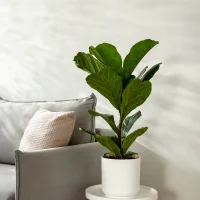
The Fiddle-leaf fig is a visual spectacle, with its large, glossy leaves making a bold statement. This plant is perfect for individuals looking to fill up an empty corner with a large indoor plant for the living room. Its towering presence can transform any space into a tropical paradise.
However, it requires a bright, indirect light source and a consistent watering schedule, making it a choice for those ready to invest a bit more care.
Keep your Fiddle-leaf Fig out of reach of pets and children as it can be toxic if ingested and may lead to mouth discomfort, increased salivation, and vomiting.
Fiddle-leaf fig care tips:
- Lighting: Place your Fiddle-leaf Fig near a bright window with filtered light, avoiding direct sunlight to prevent leaf scorch.
- Watering: Water when the top inch of soil is dry, ensuring thorough watering until water drains through the bottom of the pot, then empty the saucer to avoid waterlogging.
- Fertilization: Fertilize every month during the growing season (spring and summer) with a balanced houseplant fertilizer, reducing to every 2-3 months in the fall and winter.
- Pruning: Prune in the spring to maintain shape and size, making sure to use sharp, clean scissors or pruning shears.
- Support: Provide a sturdy stake or support as the Fiddle-leaf Fig grows tall to help maintain its structure.
12. Rubber Tree
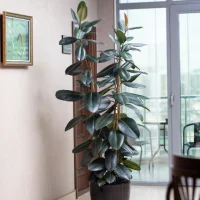
Rubber Tree is another stellar choice for those looking to introduce large indoor plants in the living room. With its robust structure and dark green leaves, it provides a stunning contrast to light-colored interiors.
Besides its aesthetic appeal, the Rubber tree is known for its air-purifying qualities, making it a functional and beautiful addition to your living room.
Be cautious as the Rubber tree’s sap can irritate skin and eyes, and the plant can be toxic to pets if ingested.
Rubber tree care tips:
- Lighting: Position your Rubber Tree near a window with bright, indirect light, avoiding harsh direct sunlight which can scorch the leaves.
- Watering: Water the plant when the top 1-2 inches of soil are dry, ensuring to drain any excess water to prevent root rot.
- Fertilization: Fertilize your Rubber Tree with a balanced liquid fertilizer every 4-6 weeks during the growing season (spring and summer).
- Cleaning and Maintenance: Wipe the leaves with a damp cloth to remove dust and keep them shiny, and trim away any yellow or damaged leaves.
13. ZZ plant
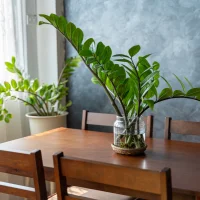
Lastly, the ZZ plant is synonymous with resilience and elegance. Its waxy, green leaves can survive in low light conditions, categorizing it among the low-maintenance best indoor plants for the living room.
The ZZ plant is not just about aesthetics; its ability to withstand neglect makes it a suitable choice for beginners or those with a hectic lifestyle.
Ensure a safe distance from pets and children. Sadly, ZZ plants join the roster of toxic houseplants, with every part posing a danger to both humans and animals if ingested.
ZZ plant care tips:
- Lighting: Situate your ZZ Plant in low to bright indirect light, steering clear of direct sunlight to avoid leaf burn.
- Watering: Water your ZZ Plant sparingly, letting the soil dry out between waterings to avert root rot.
- Fertilization: Feed your ZZ Plant with a balanced liquid fertilizer once every 4-6 weeks during the growing season (spring and summer).
- Patience: Exercise patience as ZZ Plants are slow growers but will thrive with minimal fuss and enduring care.
Must Read: Peony Growth Stages (Pictures)
14. English Ivy
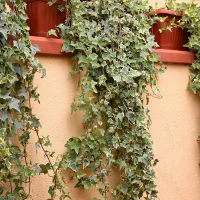
The allure of English Ivy is timeless, with its cascading vines and delicate leaves bringing a touch of nature’s elegance to your living space. Known for its versatility, it can be hung from baskets, draped over shelves, or potted in a living room corner, offering a garden-like ambiance.
Among its outstanding traits is its air purifying capability, making it a valuable indoor plant for living room air purifying. Besides its visual appeal, English Ivy can absorb toxins like benzene, making your living area a cleaner, healthier space.
Designate a safe perch for your English Ivy, away from pets and young ones, as it can be toxic when ingested.
English ivy care tips:
- Lighting: Position your English Ivy near a source of bright, indirect light, avoiding direct sun rays that may scorch its leaves.
- Watering: Quench your English Ivy’s thirst when the soil surface feels dry, ensuring a thorough soak while avoiding waterlogging.
- Temperature and Humidity: Maintain a cool, temperate setting between 50-70°F (10-21°C) with a touch of humidity, perhaps near a gently misted window.
- Fertilization: Treat your English Ivy to a balanced liquid fertilizer every month during the growth phase (spring and summer).
- Support: Provide a trellis or wall for your English Ivy to ascend, or let it cascade gracefully from a hanging basket.
15. Devil’s Ivy
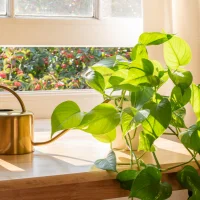
Devil’s Ivy, or Golden Pothos, is a hardy, vining plant with heart-shaped leaves that are green and yellow. Its adaptability to a variety of light conditions and its low-maintenance nature categorize it as one of the best indoor plants for the living room for beginners.
It thrives with minimal care, making it a hassle-free choice for those with busy schedules. Moreover, its trailing vines can be styled to create a green curtain or a living wall, adding a refreshing touch to your interior decor.
Place your Devil’s Ivy on a high shelf or hanging basket, out of reach from curious pets and children as it can be toxic upon ingestion.
Devil’s ivy care tips:
- Lighting: Gift your Devil’s Ivy a spot with moderate to bright, indirect light, shielding it from harsh direct sunlight which may tarnish its vibrant foliage.
- Watering: Quench its thirst when the top layer of soil feels dry to the touch, ensuring a thorough watering but letting excess water drain away to prevent soggy roots.
- Temperature and Humidity: Bestow upon it a comfortable ambiance between 60-80°F (15-27°C), with a dash of humidity to keep its lushness intact.
16. Pothos
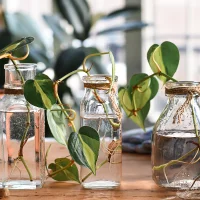
Pothos, often mistaken for Devil’s Ivy, is a charming plant with variegated leaves that can brighten up any room. Its simplicity in care requirements makes it fall under the low-maintenance best indoor plants for the living room.
The cascading vines of Pothos offer endless styling possibilities, whether you wish to hang them or let them trail along a bookshelf, bringing a lively essence to your living space.
Pothos, harmful to animals, may not be lethal but their calcium oxalates can trigger serious digestive upset, necessitating a safe distance from pets.
Pothos care tips:
- Follow the same care routine as Devil’s Ivy.
17. Aglaonema
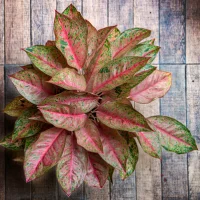
Aglaonema, also known as Chinese Evergreen, is renowned for its beautiful, patterned leaves. Its ability to thrive in low light conditions makes it a perfect indoor plant for living room corners.
Aglaonema doesn’t just sit pretty; it’s known to purify indoor air, adding a breath of fresh air to your living area. With an array of varieties to choose from, you can find the perfect Aglaonema to match your living room aesthetics.
Chinese Evergreen’s calcium oxalate crystals, when chewed or swallowed, can inflict severe mouth and gastrointestinal discomfort on pets, likely necessitating a vet checkup.
Aglaonema (Chinese Evergreen) care tips:
- Lighting: Place your Aglaonema in low to medium indirect light, embracing its tolerance for less sunny spots in your dwelling.
- Watering: Bless your Aglaonema with water when the topsoil feels dry to the touch, ensuring a thorough soak while avoiding a soggy stance.
- Temperature and Humidity: Cherish it in a warm embrace with temperatures between 65-80°F (18-27°C), and a touch of humidity to mimic its tropical homeland.
- Fertilization: Adorn its growth with a balanced liquid fertilizer every 4-6 weeks during the spring and summer, reducing to every 8-10 weeks in fall and winter.
- Pruning: Trim any leggy stems to encourage a denser growth, retaining its lush, bushy demeanor.
- Propagation: Divide its essence during repotting, or snip stem cuttings to root in water or soil, spreading the verdant love of Aglaonema.
18. Philodendron
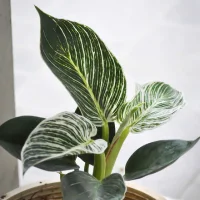
Philodendron, with its wide array of species, offers a plethora of choices to suit any interior design. Its ease of care makes it a gem among the low-maintenance best indoor plants for the living room.
Whether you choose a vining or a bushy variety, Philodendrons are capable of making a green statement in your living space. Their lush foliage can transform your living room into a tropical haven, offering a relaxing ambiance after a long day.
Housing calcium oxalate crystals, Philodendrons present toxicity risks to humans, dogs, cats, and other animals.
Philodendron care tips:
- Watering: Allow soil to dry slightly between waterings to prevent root rot.
- Sunlight: Position in a spot with medium to bright indirect light, rotating occasionally for even growth.
- Seasonal Fertilizing: During spring and summer, apply a balanced water-soluble fertilizer every 4-6 weeks to encourage vibrant foliage.
Related: Best Plants for Shallow Pots
19. Dracaena
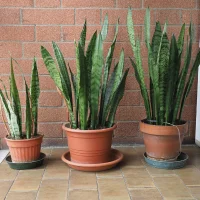
Dracaena is a family of diverse plants with a dramatic flair. Their tall, slender leaves can fill up space, making them suitable as large indoor plants for the living room. They are not just about aesthetics; they are known for their air-purifying abilities, making them functional additions to your home.
With the right choice of Dracaena, you can achieve a striking balance between elegance and a clean, fresh living environment.
Dracaena’s saponin content poses a threat to dogs and cats, potentially triggering symptoms like vomiting (possibly bloody), appetite decline, mood dips, or heightened drooling upon ingestion.
Dracaena care tips:
- Balanced Light: Aim for bright, indirect light; avoid harsh sunlight to prevent leaf scorch.
- Measured Watering: Let the soil dry out slightly before watering to avoid root rot; over-watering is a common mishap.
- Seasonal Fertilization: Apply a balanced fertilizer every 6 weeks during the growing season (spring/summer) to maintain nutrient levels for a lush appearance.
20. Swiss Cheese Plant
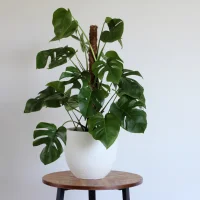
The Swiss Cheese Plant, with its unique fenestrated leaves, brings a tropical ambiance to your abode. It’s a fashionable choice for those looking to make a bold statement with large indoor plants for the living room. As it matures, the distinctive holes in its leaves become more pronounced, adding an exotic touch.
While it loves a bright spot, it’s adaptable to lower light conditions too, making it a striking yet manageable choice for any living room.
When your pets (dogs or cats) gnaw on Swiss Cheese Plant’s stems, flowers, or leaves, the released calcium oxalate crystals from the broken tips can trigger poisoning.
Swiss cheese plant care tips:
- Filtered Sunlight: Place in a location with bright, indirect sunlight to mimic its natural tropical habitat.
- Moderate Watering: Allow the top inch of soil to dry out before watering, ensuring well-draining soil to prevent waterlogging.
- Supportive Structure: As it matures, provide a moss pole or trellis to support its climbing and sprawling nature, encouraging vertical growth.
21. Jade Plant
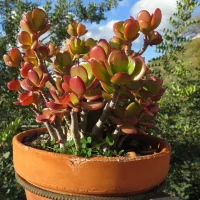
Jade Plant, often known as the “money plant,” is cherished for its succulent, round leaves and compact structure. It’s a beautiful plant requiring minimal care, making it another ideal candidate among the best indoor plants for the living room.
Its longevity and ability to thrive with minimal water make it a symbol of enduring friendship and good fortune, adding a touch of sentiment alongside greenery to your living space.
While the specific toxins in jade plants remain unidentified, they have the potential to trigger digestive upset, heart rhythm anomalies, and mood lows.
Jade plant care tips:
- Sunlight Savvy: Provide plenty of sunlight, at least 4 hours of direct sunlight daily, to maintain a compact, bushy growth.
- Watering Wisdom: Allow soil to dry out between waterings; over-watering is a common mistake that can lead to root rot.
- Nutrient Nudge: Use a balanced, slow-release fertilizer at the beginning of the growing season to support healthy growth and leaf production.
Also Read: How to Prune Creeping Phlox in Winter
22. Weeping Fig
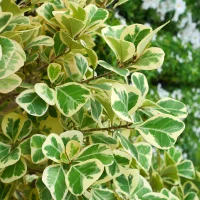
The Weeping Fig, with its graceful drooping branches and lush foliage, provides a refreshing green canopy in your living space. It’s an excellent choice for those desiring large indoor plants for the living room, capable of filling up empty corners with its expansive foliage.
While it requires a bright, indirect light source and consistent care, the visual appeal and the natural ambiance it creates are well worth the effort.
Weeping fig harbors two hazardous substances, ficusin (psoralen) and ficin (proteolytic enzyme), where ficusin can trigger severe photodermatitis in certain instances
Weeping fig care tips:
- Sunlight Balance: Position near east or north-facing windows for 4-6 hours of daily indirect sunlight, keeping temperatures between 65 to 75°F.
- Measured Watering: Water once top 1-2 inches of soil dry out, using room-temperature filtered water; more frequent in spring/summer, less in fall/winter.
- Seasonal Nourishment: Apply half-strength liquid fertilizer monthly during April to September; prune to shape, replenishing top soil carefully without harming roots.
23. Monstera
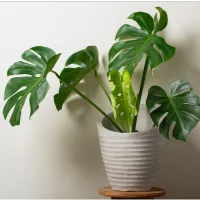
Monstera, with its iconic split leaves, is a crowd-pleaser among houseplant enthusiasts. It’s a fast grower and can become a large indoor plant for the living room, offering a tropical aesthetic.
Monstera is relatively easy to care for, requiring bright, indirect light and regular watering. Its dramatic foliage creates a lively, refreshing ambiance, making your living room feel like a tropical retreat.
Monstera carries mild toxicity for humans and is toxic to cats and dogs, but it’s not typically deadly.
Monstera care tips:
- Ideal Lighting: Position your Monstera near a window with bright, indirect sunlight. Avoid direct sunlight to prevent leaf damage.
- Balanced Watering: Maintain slightly moist soil, allowing the top inch to dry between waterings. Avoid overwatering to prevent root issues.
- Aerial Root Attention: Monstera often produces aerial roots; these can be left alone or provided with support for climbing, encouraging a healthy growth pattern.
24. Dragon Tree
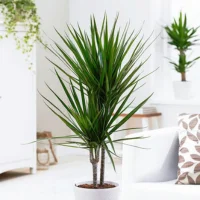
Dragon Tree, a member of the Dracaena family, is a striking plant with slender, arching leaves. It’s a robust plant that requires minimal care, fitting well in the list of low-maintenance best indoor plants for the living room.
The Dragon tree plant can grow quite tall, providing a captivating vertical element to your living room decor. Its air-purifying qualities are an added bonus, contributing to a healthier living environment.
The Dragon tree poses a danger to children and pets, making it imperative to keep them out of reach.
Dragon tree care tips:
- Optimal Light: Position your Dragon Tree in bright, indirect sunlight. It can tolerate lower light conditions, but some exposure to sunlight is ideal.
- Smart Watering: Allow the top inch of soil to dry before watering, and ensure proper drainage to prevent root problems.
- Regular Grooming: Prune leggy or yellowing leaves to promote healthy growth, and remove dead foliage to maintain its appearance and overall well-being.
See Also: China Doll Plant Care Tips, Propagation, Benefits, Problems
25. Bird of Paradise Flower
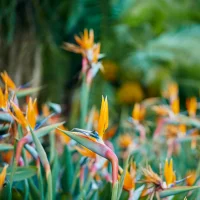
Bird of Paradise Flower, known for its large, banana-like leaves and unique bird-shaped flowers, is a statement-maker in any living room. It’s an ideal choice for those seeking large indoor plants for the living room that require low maintenance.
Its exotic, vibrant blooms and expansive foliage transport you to a tropical paradise. While it requires bright light and ample space, the Bird of Paradise Flower is a magnificent, lively plant that can transform your living room into an exotic getaway.
Bird of paradise flower is considered minimally toxic to humans. Swallowing a larger piece can potentially lead to choking. This plant may be poisonous to animals.
Bird of Paradise flower care tips:
- Sunlight Savvy: Place your Bird of Paradise in bright, indirect sunlight, but it can tolerate moderate shade.
- Smart Hydration: Water deeply when the top inch of soil dries out, ensuring proper drainage to prevent root issues.
- Prune and Repot: Trim dead or damaged leaves for a tidy appearance, and repot every 2-3 years to refresh the soil and encourage robust root growth.
26. Coleus
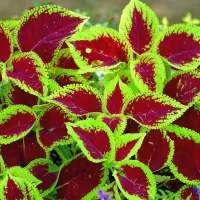
Coleus plants are great options for very sunny living rooms, bringing a splash of color with their multicolored leaves. They are often grown outdoors but fare well indoors, adding beauty and interest to your living room with their vibrant foliage.
Their striking combinations of bright green, pink, purple, red, and/or yellow leaves can be a visual treat, especially during the gloomy winter months when placed near a bright window.
Coleus poses a toxicity risk to both humans and pets, with the potential to induce skin rashes and a range of health issues upon ingestion
Coleus care tips:
- Light Elegance: Opt for bright, indirect sunlight or partial shade, avoiding harsh direct sun to protect the leaves.
- Watering Wisdom: Maintain consistent soil moisture by watering when the top inch feels dry, preventing both drought stress and waterlogging.
- Bushier Beauty: Regularly pinch off stem tips to promote a bushy, compact growth pattern, ensuring a lush and vibrant Coleus plant.
27. Lucky Bamboo
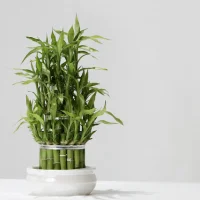
Known for its low-maintenance nature, Lucky Bamboo is among the best indoor plants for the living room, especially for those looking to attract positive energy. It grows easily in water, adding ornamental value to your space.
The plant’s availability in different sizes makes it a flexible choice for various spots in your living room, be it on a coffee table or in a living room corner.
Lucky bamboo is toxic to cats and dogs, necessitating precautions to keep it out of their reach. It’s important to note that Lucky bamboo is not toxic to humans.
Lucky bamboo care tips:
- Water Quality: Use distilled or purified water to prevent mineral buildup on the plant. Change the water every 2-4 weeks to maintain freshness.
- Indirect Light: Place Lucky Bamboo in bright, indirect light. Avoid direct sunlight, which can scorch the leaves.
- Container Maintenance: Ensure the container has adequate drainage and clean it regularly to prevent mold and algae growth in the water
Also Read: Can You Grow Peonies Indoors?
28. Trailing Jade
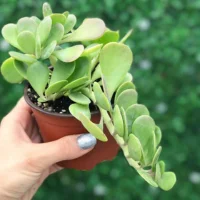
If you’re on the lookout for small-leaved houseplants with a trailing habit, Trailing Jade is a wonderful choice. This plant, with succulent-like leaves, stays very small, making it a great choice to display on end tables or coffee tables.
It’s perfect for adding a touch of greenery without overwhelming the space, and its low-maintenance nature requiring bright, indirect sunlight makes it one of the best indoor plants for the living room.
Trailing Jade plant, scientifically known as Senecio jacobsenii, is regarded as potentially toxic to both humans and pets.
Trailing jade care tips:
- Filtered Sunlight: Place your Trailing Jade near a window with filtered sunlight for optimal growth, avoiding direct sun exposure.
- Water Wisely: Water moderately, allowing the top inch of soil to dry before rewatering, and ensure well-draining soil to prevent root issues.
- Pruning Prowess: Trim leggy stems occasionally to promote a fuller, cascading appearance, keeping your Trailing Jade both lush and attractive
29. Croton
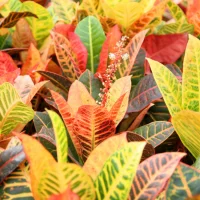
Crotons are an exceptional choice for those looking to enhance their sunny living room with colorful foliage. Their thick-leaved plant has colorful foliage combining green with any blend of orange, red, purple, yellow, and/or white.
Moreover, Crotons add a vibrant touch, and their leaves often change color over time, providing visual interest, and making your living room a lively, colorful sanctuary.
Every part of the Croton plant, from leaves to stems, roots, and blossoms, contains toxins. It’s essential to keep these plants out of reach of children and pets, and when handling them, wearing gloves is recommended
Croton care tips:
- Sunlight Sizzle: Position your Croton in bright, indirect sunlight to showcase its colorful foliage, while avoiding harsh direct sun.
- Moisture Management: Keep the soil consistently moist but not waterlogged, watering when the top inch is dry to the touch, and ensuring efficient drainage.
- Humidity Haven: Maintain high humidity by misting leaves or using a humidity tray, recreating its tropical habitat for vibrant, flourishing foliage.
30. Snake Plant
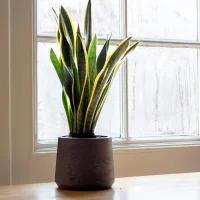
One of the crowning jewels in the realm of indoor foliage is the Snake plant. Known for its striking tall leaves and architectural beauty, it effortlessly fits into any living room corner. Its low-maintenance nature makes it a darling among beginners and busy individuals alike.
Also, the Snake plant has a remarkable ability to purify the air by removing toxins and releasing oxygen, making your living area a fresher, healthier space.
Place your Snake plant out of reach as it’s toxic to pets and children if ingested.
Snake plant care tips:
- Lighting: Place your snake plant in bright, indirect light, though it can adapt to low-light areas too.
- Watering: Water sparingly and allow the soil to dry completely between waterings to prevent root rot.
- Fertilization: Fertilize every 6-8 weeks with a balanced plant food during spring and summer, reducing to once in the fall and none in winter.
- Pest and Disease Management: Regularly check for pests like spider mites or mealybugs, treating with insecticidal soap or neem oil if necessary.
Must Read: Best Gardening Tools Names with Pictures
Conclusion
We’ve explored a colorful variety of indoor plants that bring the benefits of air purification, easy care, and safe, non-toxic greenery into your living room. Alongside, we shared some handy safety pointers and care tips for each plant to help you nurture a thriving green corner effortlessly.
My hope is that this guide has paved the way for you to pick the ideal house plants that blend well with your space and daily routine.
Your green adventure doesn’t have to stop here. If you have any questions or ideas, don’t hesitate to drop a note in the comment box below. We truly enjoy hearing from our readers and value your input.
